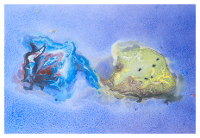Speaker
Dr
Masayasu Hasegawa
(Joint Institute for Nuclear Research)
Description
University of Kanazawa and Pisa groups have shown a number of studies which support the confinement mechanism due to monopole condensations by the lattice simulations. The close relations between the instanton and chiral symmetry breaking are theoretically explained, moreover, the relations are revealed by numerical simulations. The purpose of our study is to show that the monopoles relate to the instantons and chiral symmetry breaking by using the overlap fermions as an analytical tool.
To show the relations, first we generate SU(3) configurations for the Wilson gauge action. We construct the overlap Dirac operator from link variables of the configurations, solve the eigenvalue problems by using of the subroutines (ARPACK), and save O(80) pairs of eigenvalues and eigenvectors each configurations. We count the number of the zero modes each ensemble. After analytical computations, we confirm that the instanton density is consistent with the instanton liquid model by E. V. Shuryak.
Second, we generate configurations adding monopoles and anti-monopoles with several charges by the monopole creation operator which is defined by the University of Pisa group. Third, we fix the maximally abelian gauge. After performed the abelian projection we localize the monopoles on the lattice. We measure the length of monopole loops to confirm that the monopoles are successfully added by the monopole creation operator.
The last, we diagonalize the overlap Dirac operator of the configurations without fixing the gauge which the monopoles are added. We quantitatively verify how many the monopoles and the monopole charges create the zero modes and instantons in order to show the relations between them. Moreover, we evaluate the pseudoscalar and scalar meson masses from the eigenvalues and eigenvectors.
I will present our preliminary results.
Author
Dr
Masayasu Hasegawa
(Joint Institute for Nuclear Research)
Co-author
Prof.
Adriano Di Giacomo
(University of Pisa)
